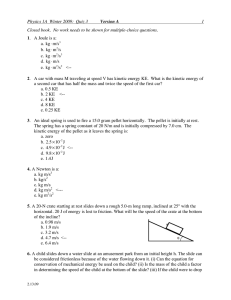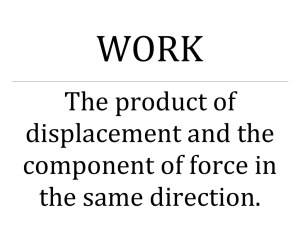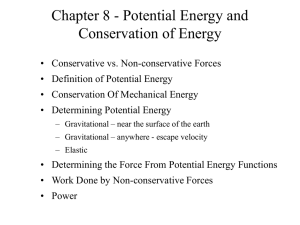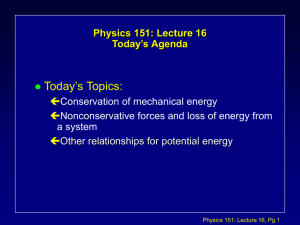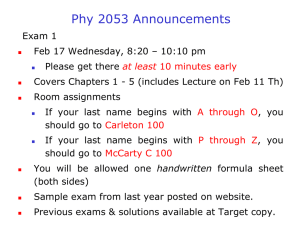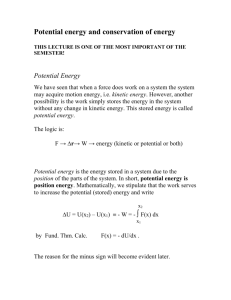Physics 106P: Lecture 12 Notes
advertisement
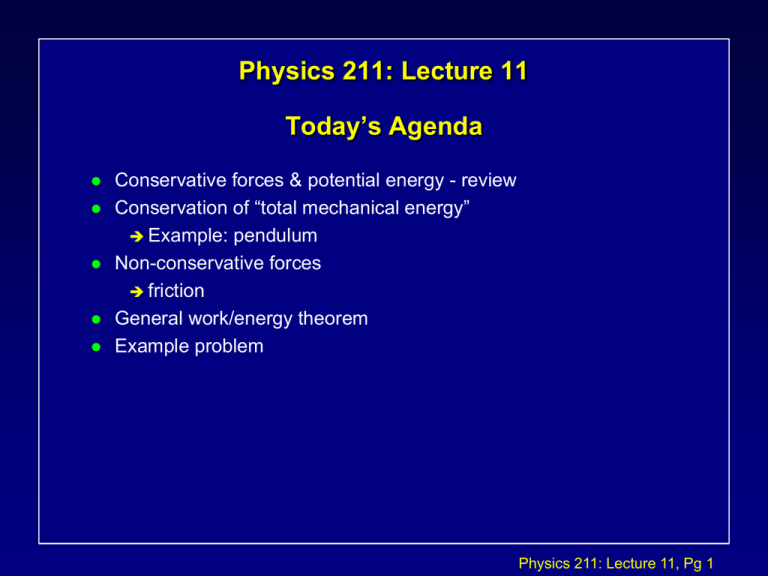
Physics 211: Lecture 11 Today’s Agenda Conservative forces & potential energy - review Conservation of “total mechanical energy” Example: pendulum Non-conservative forces friction General work/energy theorem Example problem Physics 211: Lecture 11, Pg 1 Exam 1 Question 12: Physics 211: Lecture 11, Pg 2 Exam 1 Question 15: Physics 211: Lecture 11, Pg 3 Exam 1 Question 4: Physics 211: Lecture 11, Pg 4 Exam 1 Question 18: Physics 211: Lecture 11, Pg 5 Exam 1 Question 24: Physics 211: Lecture 11, Pg 6 Conservative Forces: We have seen that the work done by gravity does not depend on the path taken. m 1 1 Wg GMm R R 2 1 R2 R1 M m h Wg = -mgh Physics 211: Lecture 11, Pg 7 Lecture 11, Act 1 Work & Energy A rock is dropped from a distance RE above the surface of the earth, and is observed to have kinetic energy K1 when it hits the ground. An identical rock is dropped from twice the height (2RE) above the earth’s surface and has kinetic energy K2 when it hits. RE is the radius of the earth. What (a) is K2 / K1? 2 2RE (b) (c) 3 2 4 3 RE RE Physics 211: Lecture 11, Pg 8 Lecture 11, Act 1 Solution 2RE RE RE Physics 211: Lecture 11, Pg 9 Lecture 11, Act 1 Solution 2RE RE RE Physics 211: Lecture 11, Pg 10 Conservative Forces: We have seen that the work done by a conservative force does not depend on the path taken. W2 W1 = W2 Therefore the work done in a closed path is 0. W1 W2 WNET = W1 - W2 = W1 - W1 = 0 W1 Physics 211: Lecture 11, Pg 11 Lecture 11, Act 2 Conservative Forces The pictures below show force vectors at different points in space for two forces. Which one is conservative ? (a) 1 (b) 2 y (c) both y x (1) x (2) Physics 211: Lecture 11, Pg 12 Lecture 11, Act 2 Solution Consider the work done by force when moving along different paths in each case: WA = WB (1) WA > WB (2) Physics 211: Lecture 11, Pg 13 Lecture 11, Act 2 In fact, you could make money on type (2) if it ever existed: Work done by this force in a “round trip” is > 0! Free kinetic energy!! WNET = 10 J = DK W=0 W = 15 J Note: NO REAL FORCES OF THIS TYPE EXIST, SO FAR AS WE KNOW W = -5 J W=0 Physics 211: Lecture 11, Pg 14 Potential Energy Recap: For any conservative force we can define a potential energy function U such that: F.dr S2 DU = U2 - U1 = -W = - S1 The potential energy function U is always defined only up to an additive constant. You can choose the location where U = 0 to be anywhere convenient. Physics 211: Lecture 11, Pg 15 Conservative Forces & Potential Energies (stuff you should know): Work W(1-2) Force F ^ Fg = -mg j Fg = GMm ^ r 2 R Fs = -kx -mg(y2-y1) 1 1 GMm R R 2 1 1 k x22 x12 2 Change in P.E DU = U2 - U1 mg(y2-y1) P.E. function U mgy + C 1 GMm 1 C GMm R R 2 R1 1 k x22 x12 2 1 2 kx C 2 (R is the center-to-center distance, x is the spring stretch) Physics 211: Lecture 11, Pg 16 Lecture 11, Act 3 Potential Energy All springs and masses are identical. (Gravity acts down). Which of the systems below has the most potential energy stored in its spring(s), relative to the relaxed position? (a) 1 (b) 2 (c) same (1) (2) Physics 211: Lecture 11, Pg 17 Lecture 11, Act 3 Solution (1) (2) Physics 211: Lecture 11, Pg 18 Lecture 11, Act 3 Solution Physics 211: Lecture 11, Pg 19 Conservation of Energy If only conservative forces are present, the total kinetic plus potential energy of a system is conserved, i.e. the total “mechanical energy” is conserved. (note: E=Emechanical throughout this discussion) E=K+U DE = DK + DU using DK = W = W + DU = W + (-W) = 0 using DU = -W E = K + U is constant!!! Both K and U can change, but E = K + U remains constant. But we’ll see that if non-conservative forces act then energy can be dissipated into other modes (thermal,sound) Physics 211: Lecture 11, Pg 20 Example: The simple pendulum Suppose we release a mass m from rest a distance h1 above its lowest possible point. What is the maximum speed of the mass and where does this happen? To what height h2 does it rise on the other side? m h1 h2 v Physics 211: Lecture 11, Pg 21 Example: The simple pendulum y y=0 h1 h2 v Physics 211: Lecture 11, Pg 22 Example: The simple pendulum y y=0 Physics 211: Lecture 11, Pg 23 Example: The simple pendulum y y = h1 y=0 h1 v Physics 211: Lecture 11, Pg 24 Example: Airtrack & Glider A glider of mass M is initially at rest on a horizontal frictionless track. A mass m is attached to it with a massless string hung over a massless pulley as shown. What is the speed v of M after m has fallen a distance d ? v M m d v Physics 211: Lecture 11, Pg 31 Example: Airtrack & Glider Glider v M m d Physics 211: Lecture 11, Pg 32 Problem: Hotwheel A toy car slides on the frictionless track shown below. It starts at rest, drops a distance d, moves horizontally at speed v1, rises a distance h, and ends up moving horizontally with speed v2. Find v1 and v2. v2 d v1 h Physics 211: Lecture 11, Pg 33 Problem: Hotwheel... d v1 h Physics 211: Lecture 11, Pg 34 Problem: Hotwheel... d-h d v2 h Physics 211: Lecture 11, Pg 35 Non-conservative Forces: If the work done does not depend on the path taken, the force is said to be conservative. If the work done does depend on the path taken, the force is said to be non-conservative. An example of a non-conservative force is friction. When pushing a box across the floor, the amount of work that is done by friction depends on the path taken. » Work done is proportional to the length of the path! Physics 211: Lecture 11, Pg 36 Energy dissipation: e.g. sliding friction As the parts scrape by each other they start small-scale vibrations, which transfer kinetic and potential energy into atomic motions The atoms’ vibrations go back and forththey have energy, but no average momentum. Physics 211: Lecture 11, Pg 37 Non-conservative Forces: Friction Suppose you are pushing a box across a flat floor. The mass of the box is m and the coefficient of kinetic friction is k. The work done in pushing it a distance D is given by: Wf = Ff • D = -kmgD. Ff = -kmg D Physics 211: Lecture 11, Pg 38 Non-conservative Forces: Friction Since the force is constant in magnitude and opposite in direction to the displacement, the work done in pushing the box through an arbitrary path of length L is just Wf = -mgL. Clearly, the work done depends on the path taken. Wpath 2 > Wpath 1 B path 1 path 2 A Physics 211: Lecture 11, Pg 39 Generalized Work/Energy Theorem: Suppose FNET = FC + FNC (sum of conservative and nonconservative forces). The total work done is: WNET = WC + WNC The Work/Kinetic Energy theorem says that: WNET = DK. WNET = WC + WNC = DK WNC = DK - WC But WC = -DU So WNC = DK + DU = DEmechanical Physics 211: Lecture 11, Pg 40 Problem: Block Sliding with Friction A block slides down a frictionless ramp. Suppose the horizontal (bottom) portion of the track is rough, such that the coefficient of kinetic friction between the block and the track is k. How far, x, does the block go along the bottom portion of the track before stopping? d k x Physics 211: Lecture 11, Pg 42 Problem: Block Sliding with Friction... d k x Physics 211: Lecture 11, Pg 43 Recap of today’s lecture Conservative forces & potential energy - review Conservation of “Total Mechanical Energy” (Text: 7-1) Examples: pendulum, airtrack, Hotwheel car Non-conservative forces (Text: 6-4) friction General work/energy theorem (Text: 7-2) Example problem Physics 211: Lecture 11, Pg 44

